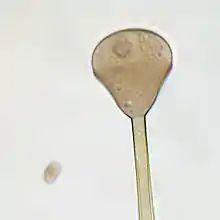Apophysomyces
Apophysomyces is a genus of filamentous fungi that are commonly found in soil and decaying vegetation. Species normally grow in tropical to subtropical regions.[1]
| Apophysomyces | |
|---|---|
 | |
| Scientific classification | |
| Kingdom: | |
| Division: | |
| Class: | |
| Order: | |
| Family: | |
| Genus: | Apophysomyces P.C.Misra (1979) |
| Type species | |
| Apophysomyces elegans P.C.Misra, K.J.Srivast. & Lata (1979) | |
| Species | |
|
A. elegans | |
The genus Apophysomyces historically was monospecific, containing only the type species Apophysomyces elegans. In 2010, three new species were described: variabilis, trapeziformis, and ossiformis.[2]
Characteristics
Among the other members of zygomycetes, Apophysomyces elegans mostly resembles those from genus Absidia. However, its bell-shaped (although not conical) apophyses (outgrowth), the existence of its foot-cell like hyphal segment, rhizoids produced opposite to the sporangiophores upon cultivation on plain agar, the darker and thicker subapical segment, and inability to sporulate on routine culture media help in distinguishing Apophysomyces elegans.[3]
Apophysomyces elegans is a thermotolerant fungus: it has been found to grow favourably at temperatures of 26 °C and 37 °C, and it grows rapidly at 42 °C. Its colonies are fluffy and cottony in appearance. The surface of the colony is white initially and turns to a brownish-grey or yellowish-cream as the culture ages, while the underside is white to pale yellow in colour.[3][4]
Pathogenicity
Normally, no special precautions are needed with regard to this fungus.
However, Apophysomyces elegans and Apophysomyces trapeziformis are able to cause mucormycosis, in humans, which is often fatal but very rare.[5][6][7] Reports of other mammals being infected are mostly restricted to captive species, but in 2021 a female lesser long-nosed bat was found with mucormycosis in the wild.[8]
Infection is usually acquired via traumatic implantations associated with soil or decaying vegetable matter (such as from accidental injuries or insect bites). Invasive soft tissue infections can develop on burns or wounds which are contaminated by soil. Unlike other zygomycosis, the affected host is usually otherwise immunocompetent. Apophysomyces elegans infections present most commonly as necrotizing fasciitis and/or osteomyelitis.[6][9][10] Systemic[11] and secondary renal and bladder infections[12] have also been reported.
See also
- Mucormycosis (specific term for infection caused by fungi of the order Mucorales)
- Zygomycosis (a more generic term for infection caused by Mucoraceae and various other fungus varieties; the term Mucormycosis is preferred).
References
- L. Collier, A. Balows, and M. Sussman, "Topley & Wilson's Microbiology and Microbial Infections", 9th ed. (1998), vol. 4. (London, Sydney, Auckland, New York). ISBN 0-340-80912-4 (ISBN is for 10th ed.)
- Alvarez, Eduardo; Stchigel, Alberto M.; Cano, Josep; Sutton, Deanna A.; Fothergill, Annette W.; Chander, Jagdish; Salas, Valentina; Rinaldi, Michael G.; Guarro, Josep (2010). "Molecular phylogenetic diversity of the emerging mucoralean fungus Apophysomyces: Proposal of three new species". Revista Iberoamericana de Micología. 27 (2): 80–9. doi:10.1016/j.riam.2010.01.006. PMID 20199897.
- Davise H. Larone, "Medically Important Fungi - A Guide to Identification", 3rd ed. (1995). (ASM Press, Washington, D.C.). ISBN 1-55581-172-8 (ISBN is for 4th ed.)
- L. Collier, A. Balows, and M. Sussman, "Topley & Wilson's Microbiology and Microbial Infections", 9th ed. (1998), vol. 4, p. 463. (London, Sydney, Auckland, New York). ISBN 0-340-80912-4 (ISBN is for 10th ed.)
- Ribes, J. A.; Vanover-Sams, C. L.; Baker, D. J. (2000). "Zygomycetes in Human Disease". Clinical Microbiology Reviews. 13 (2): 236–301. doi:10.1128/CMR.13.2.236. PMC 100153. PMID 10756000.
- Cooter, RD; Lim, IS; Ellis, DH; Leitch, IO (1990). "Burn wound zygomycosis caused by Apophysomyces elegans". Journal of Clinical Microbiology. 28 (9): 2151–3. doi:10.1128/jcm.28.9.2151-2153.1990. PMC 268128. PMID 2229400.
- Echaiz, Jose F.; Burnham, Carey-Ann D.; Bailey, Thomas C. (2013). "A case of Apophysomyces trapeziformis necrotizing soft tissue infection". International Journal of Infectious Diseases. 17 (12): e1240–e1242. doi:10.1016/j.ijid.2013.06.008. ISSN 1201-9712. PMID 23891642.
- López-Romero, Teresa; Ramírez-Bravo, O. Eric; Camargo-Rivera, E. Evangelina; Jiménez-García, Daniel; Bernal-Mendoza, Héctor; Marques, Roberta (15 November 2021). "Detection of mucormycosis caused by Apophysomyces elegans in a Lesser Long-nosed Bat (Leptonycteris yerbabuenae) in Central Mexico". Neotropical Biology and Conservation. 16 (4): 493–499. doi:10.3897/neotropical.16.e73365. eISSN 2236-3777.
- Lakshmi, V; Rani, TS; Sharma, S; Mohan, VS; Sundaram, C; Rao, RR; Satyanarayana, G (1993). "Zygomycotic necrotizing fasciitis caused by Apophysomyces elegans". Journal of Clinical Microbiology. 31 (5): 1368–9. doi:10.1128/jcm.31.5.1368-1369.1993. PMC 262941. PMID 8501244.
- Wieden, MA; Steinbronn, KK; Padhye, AA; Ajello, L; Chandler, FW (1985). "Zygomycosis caused by Apophysomyces elegans". Journal of Clinical Microbiology. 22 (4): 522–6. doi:10.1128/jcm.22.4.522-526.1985. PMC 268459. PMID 4077963.
- Lawrence, R.M.; Snodgrass, W.T.; Reichel, G.W.; Padhye, A.A.; Ajello, L.; Chandler, F.W. (1986). "Systemic zygomycosis caused byApophysomyces elegans". Medical Mycology. 24 (1): 57–65. doi:10.1080/02681218680000071. PMID 3701543.
- Okhuysen, P. C.; Rex, J. H.; Kapusta, M.; Fife, C. (1994). "Successful Treatment of Extensive Posttraumatic Soft-Tissue and Renal Infections Due to Apophysomyces elegans". Clinical Infectious Diseases. 19 (2): 329–31. doi:10.1093/clinids/19.2.329. PMID 7986910.
External links
- Image of Apophysomyces sp.
- doctorfungus.org entry on Apophysomyces sp.
- Apophysomyces species from Index Fungorum
- PubMed search page (using search term "apophysomyces")